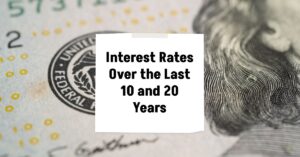As we progress into 2025, many are asking, Will Fed interest rates go down in 2025? Current insights suggest that while some modest declines are expected, aggressive cuts are unlikely. Federal Reserve held interest rates steady after their latest policy meeting in January 2025, drawing sharp criticism from President Trump. Predictions indicate that the average federal funds rate may stabilize around 3.00% to 3.25% by the end of 2025, reflecting a cautious yet optimistic approach from the Federal Reserve as it seeks to balance inflation control with economic growth.
Will Fed Interest Rates Go Down in 2025?
Key Takeaways:
- Stabilization of Rates: Predicted rates are likely to stabilize at around 3.00% to 3.25% by late 2025.
- Historical Context: The federal funds rate, which has been significantly raised in recent years to combat inflation, peaked at roughly 5.25% to 5.50% in 2023.
- Gradual Rate Cuts: Analysts expect the Fed to implement gradual cuts, with estimates of a federal funds rate of 2.75% to 3.00% at year-end 2025.
- Economic Factors: Inflation is anticipated to decrease, affecting overall economic conditions and borrowing costs.
- Political Dynamics: Future rate changes may be influenced by evolving policy decisions and administrative changes following the upcoming election.
The Federal Reserve: Understanding Its Role
The Federal Reserve, often just called the Fed, serves as the central bank of the United States. Its primary responsibilities include regulating the country’s monetary policy, which primarily entails controlling interest rates to ensure economic stability.
When the economy is overheating—often indicated by high inflation—the Fed increases interest rates to make borrowing more expensive. This action tends to slow down consumer spending and business investments, ultimately cooling the economy. On the contrary, when economic growth is sluggish, the Fed may lower rates to encourage borrowing and stimulate spending.
In recent years, the Fed has been in a tightening cycle, raising rates significantly to combat inflation that rose sharply post-pandemic. For instance, as of late 2023, the federal funds rate was maintained at 5.25% to 5.50%, marking a historic high that reflects the urgent need to control inflation (source).
Current Economic Climate and Interest Rates
To forecast whether Fed interest rates will go down in 2025, it is essential to evaluate key economic indicators:
- Inflation Trends: Economic forecasts suggest a moderate decrease in inflation, projected to fall from 3.7% in 2023 to approximately 2.4% in 2024, and average around 1.8% from 2025 to 2028 (source). Sustained low inflation could prompt the Fed to lower rates to maintain economic growth.
- Economic Growth: Economic growth was predicted to slow to about 2% in 2025 (source). Slower growth might necessitate lower rates to promote spending and investment, especially if inflation is under control.
- Labor Market and Wages: The state of the job market significantly impacts consumer spending and can, in turn, affect inflation. If wages grow steadily without leading to higher inflation, the Fed may find it appropriate to reduce interest rates.
- Political Influences: With an upcoming election, shifts in political power can bring about changes in policies that influence the economy. Possible changes under a new administration, particularly concerning fiscal policies, might prompt the Fed to adjust its interest rate strategy (source).
Expert Predictions on Interest Rate Cuts
Recent studies and expert analyses have shed light on the anticipated movements of the Fed's interest rates:
- Market Expectations: Analysts from Morningstar predict that by the end of 2025, the federal funds rate will hover between 3.00%-3.25%, with industry-wide expectations recommending caution given current inflation dynamics (source).
- Federal Reserve Projections: According to the Federal Reserve's projections from June 2024, policymakers indicated the likelihood of only one rate cut for 2024 but there have been 2 rate cuts. Policymakers foresee as many as four cuts through 2025, leading to a target rate in the 4.1% area by the end of that timeframe (source).
- Overall Sentiment: Fitch Ratings also suggests that aggregate rate cuts will remain modest overall through the easing cycle, further highlighting that while some reductions are likely, they will not dramatically shift from current levels (source).
Implications for Borrowers and Consumers
A decrease in interest rates in 2025 can have widespread implications for various sectors of the economy:
- Mortgage Rates: If rates do drop as predicted, homebuyers could see lower costs for mortgages, making homeownership more attainable for many. Lower rates can lead to higher home purchases, stimulating the housing market.
- Student Loans: Lower rates often directly affect student loans. If the Fed decreases the funds rate, borrowers could benefit from reduced interest costs, ultimately making education financing more affordable (source).
- Investment Decisions: Investors also keep a keen eye on interest rates. For instance, with lower borrowing costs, companies might invest more in growth projects, potentially leading to higher stock prices. Conversely, if the rate remains high or reduces minimally, this could dampen market enthusiasm.
The Path Forward: What to Expect in 2025
As we gaze into the crystal ball of economic forecasting, it's clear that while some cuts in interest rates are likely, a complete overhaul of the current rate environment seems improbable. The Fed's cautious approach demonstrates its commitment to balancing various economic factors, seeking not to stifle growth while simultaneously keeping inflation in check.
Communicating the complexities of these decisions to the public is crucial, especially as economic realities evolve. In every financial decision, from setting the household budget to planning long-term investments, understanding how Fed decisions influence personal and corporate finances is vital.
Conclusion
The trajectory of federal interest rates in 2025 may not promise drastic decreases, but gradual reductions might provide needed relief for consumers and borrowers alike. As we move forward, keeping a close eye on economic indicators will be essential to understanding the Fed's evolving strategy in response to the prevailing economic landscape.
Recommended Read:
- Interest Rate Predictions for 2025 and 2026 by NAR Chief
- Fed Funds Rate Forecast 2025-2026: What to Expect?
- How Low Will Interest Rates Go in the Coming Months?
- Fed Just Made a BIG Move by Slashing Interest Rates to 4.75%-5%
- Market Reactions: How Investors Should Prepare for Interest Rate Cut
- How Low Will Interest Rates Go in 2024?
- Interest Rate Predictions for the Next 3 Years: (2024-2026)
- Interest Rate Predictions for Next 2 Years: Expert Forecast
- Impact of Interest Rate Cut on Mortgages, Car Loans, and Your Wallet
- Interest Rate Predictions for Next 10 Years: Long-Term Outlook
- When is the Next Fed Meeting on Interest Rates in 2024?
- Interest Rate Cuts: Citi vs. JP Morgan – Who is Right on Predictions?
- More Predictions Point Towards Higher for Longer Interest Rates



